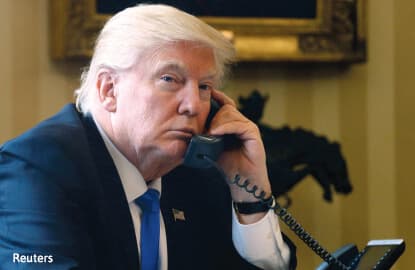
THE post-election movements of US stocks have been heavily influenced by policy. First they soared, then they traded in a narrow range. Now the markets have entered a period of greater volatility underpinned by a tug of war between the expectation of reflationary policies and the risk of stumbling into stagflation. Where we end up will be predominantly a political call.
Phase I: Euphoric markets
The markets’ euphoric phase started in the early morning of Nov 9, when President-elect Donald Trump delivered his acceptance speech. It lasted until mid-December.
Trump’s remarks at the Hilton Hotel were conciliatory in tone and notably pro-growth in content. They calmed markets that had been concerned about some of his campaign rhetoric, especially when it came to the imposition of prohibitive import taxes on China and Mexico, the dismantling of the North American Free Trade Agreement and the cancellation of bilateral trade agreements. Having sold off sharply in the run-up to the acceptance speech, US Dow Jones Industrial Average (Dow) futures erased an 800-point drop and the S&P 500 Index climbed off its limit-down level, starting what turned out to be an impressive market surge that set records for the major indices.
This first phase was fuelled by expectations that, after years of frustrating gridlock on Capitol Hill, the president and the Republican majorities in both houses of Congress would work constructively to unleash the significant potential of the US economy. Markets internalised expectations for policy-induced improvements in growth and inflation, and their translation into higher corporate revenue and stronger pricing power. It was also hoped that stocks would get a boost from higher repurchase activity thanks to the policies that encouraged companies to repatriate cash held abroad. And all of this also fed a surge in both the US dollar and yields on US Treasuries.
Phase II: Consolidating markets
Policy announcements can only take you so far in asset markets, especially when the president-elect hasn’t been sworn in. That is why, from mid-December to Trump’s inauguration on Jan 20, stocks traded in a remarkably narrow range as markets waited for information on the detailed design of policies and their implementation. The US dollar gave back some gains and yields retraced part of their pronounced upward movement.
Phase III: Twitchier markets
After the inauguration, markets became more fidgety, with sharper moves up or down depending on the latest policy indicators. On the one hand, for example, the deregulation signal provided by the executive order on pipelines took major averages to new records, including a move above the 20,000 milestone for the Dow. On the other hand, concerns about protectionism, fuelled by talk of a 20% tariff on Mexico or the travel ban affecting seven countries, drove stocks lower. In both cases, the moves were larger than what had been seen in the second phase.
There is a bigger issue at play here, and its implications go well beyond financial markets. Now that the baseline of low and insufficiently inclusive growth has become less secure due to economic, financial, institutional and political factors, the policy-driven economy could be getting nearer to a tipping point: into beneficial reflation or damaging stagflation.
Specifically, the implementation of a well-designed set of policies built around the president’s three headline initiatives — tax reform, deregulation and infrastructure — would unleash reflationary forces that would validate existing asset valuation, and could take them a lot higher if the rest of the world were also to improve its policy mix. If, however, the US stumbled into protectionism and trade wars, the markets would give up more of the recent gains, and possibly even overshoot on the way down.
Where markets go from here is therefore a matter of politics more than anything else, with both US and international dimensions. I leave you to make the call. I will limit myself to a simple observation: Having patiently waited for quite a while, markets are now a lot twitchier and point to a period of greater volatility for traders and investors. — Bloomberg
This column does not necessarily reflect the opinion of the editorial board or Bloomberg LP and its owners.